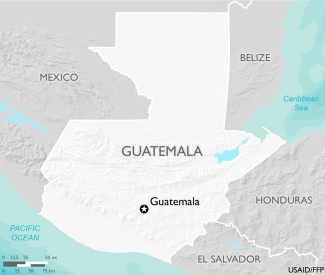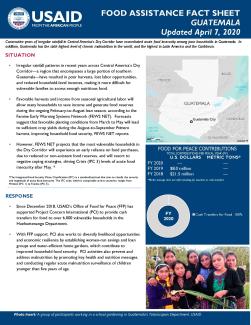April 7, 2020
Consecutive years of irregular rainfall in Central America’s Dry Corridor have exacerbated acute food insecurity among poor households in Guatemala. In addition, Guatemala has the sixth highest level of chronic malnutrition in the world, and the highest in Latin America and the Caribbean.
Situation
- Irregular rainfall patterns in recent years across Central America’s Dry Corridor—a region that encompasses a large portion of southern Guatemala—have resulted in poor harvests, lost labor opportunities, and reduced household-level incomes, making it more difficult for vulnerable families to access enough nutritious food.
- Favorable harvests and income from seasonal agricultural labor will allow many households to save income and generate food reserves during the ongoing February-to-August lean season, according to the Famine Early Warning Systems Network (FEWS NET). Forecasts suggest that favorable planting conditions from March to May will lead to sufficient crop yields during the August-to-September Primera harvest, improving household food security, FEWS NET reports.
- However, FEWS NET projects that the most vulnerable households in the Dry Corridor will experience an early reliance on food purchases, due to reduced or non-existent food reserves, and will resort to negative coping strategies, driving Crisis (IPC 3) levels of acute food insecurity after May.*
*The Integrated Phase Classification (IPC) is a standardized tool that aims to classify the severity and magnitude of food insecurity. The IPC scale, which is comparable across countries, ranges from Minimal (IPC 1) to Famine (IPC 5).
Response
- Since December 2018, USAID’s Office of Food for Peace (FFP) has supported Project Concern International (PCI) to provide cash transfers for food to over 6,000 vulnerable households in the Huehuetenango Department.
- With FFP support, PCI also works to diversify livelihood opportunities and economic resilience by establishing women-run savings and loan groups and water-efficient home gardens, which contribute to improved household food security. PCI activities also prevent and address malnutrition by promoting key health and nutrition messages, and conducting regular acute malnutrition surveillance of children younger than five years of age.
Food for Peace Contributions
Total Contributions:
| U.S. Dollars | Metric Tons | |
|---|---|---|
| Fiscal Year 2020 | ---- | ---- |
| Fiscal Year 2019 | $8.0 million | ---- |
| Fiscal Year 2018 | $21.5 million | ---- |
* Metric tonnage does not reflect funding for vouchers or cash transfers.
Related Resources
Image

(228.63 KB)

